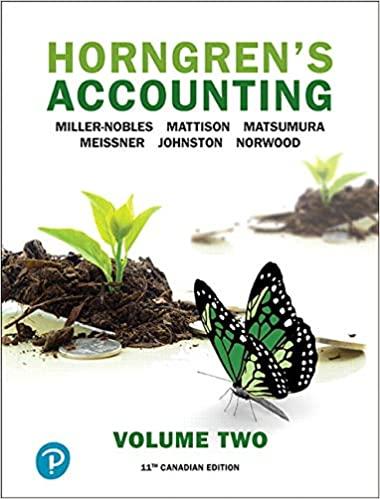Question
Create a financial analysis for Ryan-Key Inc. RK is considering expanding. RK invested $200,000 in a study to see if this expansion was possible. Below
Create a financial analysis for Ryan-Key Inc. RK is considering expanding. RK invested $200,000 in a study to see if this expansion was possible. Below are two options for the expansion.
Option A:
- lower level of fixed costs, 10% less risk than an average project
- Requires additional plant, equipment, and technology of $2,200,000.
- The plant, equipment, and technology are classified as MACRS 5-year property.
- Useful life of the equipment, however, is 7 years; at the conclusion of the 7-year period, it is estimated that the salvage value will be $250,000.
- Inventories will increase by $140,000
- Accounts receivable will increase by $135,000
- Accounts payable will increase by $80,000.
Expected Revenues and Operating Costs- Option A
| Year | Revenue | Operating Costs |
| 2021 | $1,100,000 | $510,000 |
| 2022 | $1,200,000 | $530,000 |
| 2023 | $1,300,000 | $560,000 |
| 2024 | $1,350,000 | $570,000 |
| 2025 | $1,250,000 | $585,000 |
| 2026 | $1,150,000 | $595,000 |
| 2027 | $1,050,000 | $600,000 |
Option B:
- higher level of fixed costs, 20% more risk than average project
- Requires additional plant, equipment, and technology of $6,100,000
- The plant, equipment, and technology are classified as MACRS 5-year property.
- Useful life of the equipment, however, is 7 years; at the conclusion of the 7-year period, it is estimated that the salvage value will be $360,000.
- Inventories will increase by $180,000
- Accounts receivable will increase by $150,000
- Accounts payable will increase by $85,000.
Expected Revenues and Operating Costs - Option B
| Year | Revenue | Operating Costs |
| 2021 | $1,700,000 | $380,000 |
| 2022 | $1,875,000 | $390,000 |
| 2023 | $1,975,000 | $400,000 |
| 2024 | $2,075,000 | $410,000 |
| 2025 | $2,150,000 | $420,000 |
| 2026 | $2,000,000 | $420,000 |
| 2027 | $1,800,000 | $425,000 |
RK's capital structure:
| Component | Description |
| Long-term Debt | $1000 par, 9% coupon bonds with 16 years until maturity. 10,000 bonds outstanding. Current market price of $1050.00. Your investment bankers estimate that, at your investors' current required rate of return, new bonds could be sold at par minus 5% flotation costs. |
| Preferred Stock | $100 par, 11% dividend preferred stock, currently selling for $110.00. 16,000 shares outstanding. Your investment bankers estimate that ETMC could issue new preferred stock at par at your investors' current required rate of return, but with a $2 per share discount and $3.75 per share flotation costs. |
| Common Stock | 200,000 outstanding shares, with a book value of $46 per share and a $68.00 current market price per share. Dividend history shown below. Your investment bankers estimate that you could issue additional common stock shares with $2 per share underpricing and with flotation costs of $5.00 per share. |
| Year | Dividend |
| 2020 | $3.95 |
| 2019 | $3.76 |
| 2018 | $3.58 |
| 2017 | $3.41 |
| 2016 | $3.25 |
- Currently, the rate of return for the stock market is 9.9%, and the risk-free rate is 4.7%. RK's corporate beta is 1.35.
- RK is in the 24 percent tax bracket.
- RK uses a 4-year decision rule for payback period.
If RK chooses not to expand, it can sell the proposed expansion site for $500,000.
- In determining weights for the capital structure, you know that a market-value, target-weights capital structure is best. But when you asked the CFO what the target weights were, he said, "we don't know." So, you'll just have to do the next best thing rather than the best thing.
- In your finance courses at the university, you learned that the cost of equity can be estimated using Gordon's Model or the CAPM. Do these two approaches come up with the same result? If not, which should you use for your analysis, and why?
- You have the information you need to use either non-risk-adjusted or risk-adjusted rates. Which should you use for your analysis, and why?
- You know that the required rate of return on retained earnings (rs) is less than the required rate of return on newly issued common stock (rncs). Your analysis of the financial condition of the firm, however, indicates that there is not sufficient cash being generated from retained earnings to finance either of these projects.
Step by Step Solution
There are 3 Steps involved in it
Step: 1

Get Instant Access to Expert-Tailored Solutions
See step-by-step solutions with expert insights and AI powered tools for academic success
Step: 2

Step: 3

Ace Your Homework with AI
Get the answers you need in no time with our AI-driven, step-by-step assistance
Get Started


